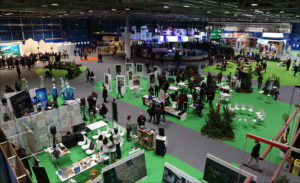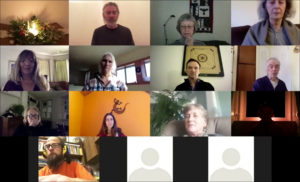A huge exhibition hall is full of people who communicate their ideas on stands and project walls. There is much movement and bustle with many conversations taking place. It is loud and hectic, and often, tense activity and stress seem to dominate the atmosphere.

At one point, however, things are different. There’s a red carpet on the floor, and there are two chairs on it. People sit down on the chairs and look at each other in silence. Minutes pass. Many minutes. Seemingly unspectacular. There seems to be a calming influence here. Anyone who walks through the hall in a goal-oriented and hectic manner will not notice this. However, for the attentive observer, for the one who is open to subtle vibrations, for him, this event unfolds a magical attraction …
On the red carpet in the “Green Zone”
It is the project “The Citizen is Present” that takes place here. In the “green zone” of the COP25 climate conference in December 2019, the arena where “civil society could articulate itself in an interactive and participatory way”.

The project group almost had to stay outside. As if by a miracle, participation in the official program was made possible after all – under the name “The Citizen is Present – Silent Integration”, for four days from 9 a.m. to 6 p.m. So it should be.
The UN Climate Conference took place in Madrid from 2 to 15 December in the IFEMA exhibition halls (it was delayed due to disagreement; it had to be renegotiated). Some 25,000 participants from all over the world attended, including a great number of ministers and government representatives.

The total costs of the conference: about 50 million euros. The outcome of the conference is generally assessed as very poor to totally insufficient.
We live in incredible times. In the face of globally significant issues such as climate change, social unrest, and political instability, life seems to invite us to find new ways to relate to the world around us.
In December 2019, people from the community around Thomas Hübl took part in some inspiring projects and explored this new territory. There was the Virtual Cave Meditation, the Collective Online Presencing initiative, and “The Citizen is Present” in Madrid.
“The Citizen is Present” in Madrid
“We traveled to Madrid as representatives of the common field of the Thomas Hübl sangha and as representatives of our initiative for the UN Climate Change Conference. We had already been supported materially by many from the Sangha before – through a crowdfunding campaign, the travel expenses were collected (thank you!).

Our team in Madrid consisted of: Susi Sanchez-Puga, Carmen Garcia, Sonia Herrero, Robin Alfred, Martin Bruders, and Axel Perinchery. We networked with parallel initiatives and were supported as if by concentric energetic circles. ‘It was wonderful to feel the subtle presence of the meditators from the other projects. Thank you!’ Niko
We went to Madrid because we believe that human connections, a present relationship space, and the ability to witness are necessary to find new solutions to today’s complex global challenges, such as the climate crisis.
The experiences we had on and around our carpet made a lasting impression on us. Up to now, we have been on the road in the public spaces of cities, and now for the first time, at a conference like this. Many people took advantage of our offer to give space in silent contact to what moves them inwardly and emotionally in the topic of climate and the negotiation situation of the states. There were so many touching moments of deep connection where the emotions from anger to sadness could get their space. After sitting, many people also sought to talk to us in order to process what they had experienced.
It was astonishing how many people shared the realization after sitting down that they could feel more the connection between their inner experience and what we outwardly call climate crisis. The inner dimension of this crisis became the theme.
This was felt even by government representatives, who sat on the chair. This surprised and delighted us.

For all of our team, the conference in Madrid was a deep spiritual experience. In the whole volume and also the optical overstimulation, silence and timelessness became more and more apparent to us over the days. This field became stronger. We noticed this because we were able to reconnect to this energy every following day. We have left something behind, even if it is not visible at first!
We want to continue with this work, this practice, and the cooperating initiatives, and are already planning for the next climate conference. This will take place in Glasgow in November 2020. Our goal: to be present at the negotiations in the ‘blue zone’, to testify and to hold the space for what life wants!” (Axel Perinchery)
Global Virtual Cave Meditation
“The virtual CAVE meditation took place around the clock throughout December. It was carried through a field of about 600 participants from many countries, of whom there were always a few, and often very many at the same time, were meditating. In three cities, groups also met in real life for a weekend of meditation as part of the Cave Meditation.

During the climate conference, everyone was invited to focus the last 10 minutes of each meditation session on what was happening in Madrid and on the people from our field there.
In networking with the other projects, the field of meditation has expanded energetically with the intention of ‘sharing our love for the sacred’. Participants of the Cave Meditation were very grateful that they had the opportunity to connect with the climate conference in a way that was appropriate and valuable for them.
I enjoyed our fellowship so much and I felt blessed to have the opportunity to contribute to the climate conference. It’s beautiful and so valuable to have space like this! Christine
Over the days, this CAVE meditation generated a force that could and would make itself available”. (Susanne Ahlendorf)
Collective Online Presencing
“Our initiative offered the opportunity to connect twice a day via video conference during the climate conference in Madrid. At first, we sat in silence for 40 minutes, and in the last two minutes, we turned our focus to Madrid and the people there. Afterward, a group exchange took place. Each time 20 to 35 people participated.

We explored the fear that echoed with this theme and seemed to suck the spatiality out of the room. We felt how the collective presence seemed to open a valve and let the air return like a fresh, gentle wind. We felt the deep nurturing timelessness of the shared silence.
Sitting in silence with others, witnessing challenging issues, and allowing emotions to wash through me like a tsunami, allowed me to experience the divine beauty of sacred activism. I felt that I had a voice and that this voice can make a difference. Together, the grounding felt more stable, and the room became more spacious.” (Scott Ligertwood)
The climate crisis as a relationship event
Despite the meager outcome of the negotiations at the climate conference in Madrid, great hope has arisen among the participants of this project who were present on-site in Madrid. The path that emerges seems to be one of relating differently and of re-connecting.
Karen O’Brian, a speaker at the Celebrate Life Festival 2019 and the Collective Trauma Online Summit on the topic of the climate crisis, also takes the view that the climate crisis is a relationship problem. Karen advokates for a shift in the focus of understanding climate change as an environmental problem to that of a disturbance on the relationship level. This allows us to explore and find further and deeper answers for the necessary transformation.

Exactly where this project has started is like a kind of energetic acupuncture at a central meridian: on the relational level in a hotspot of the worldwide climate events.
This is by starting to relate to each other and the earth as a whole in a different way, in a more conscious way, with more silence and meditation, with more presence, with deceleration, with more self-reference, and without conditioning from the past.
Those who do not feel themselves can hardly establish a healthy relationship with Planet Earth and Mother Nature. Those who experience themselves as separate are more likely to develop fragmented solutions.
The event on site were embedded and supported by a large network of relationships and meditation. This is an example of the creation of a collective we-space. In this way, hope can arise, even if the outcome of the negotiations at the climate conference are frustrating.
Deceleration, trauma and climate change
“Collective trauma, or the fragmentation of the system, always leads us to believe that we do not have enough time. And that’s very interesting, because now we are riding the emergency wave. Not that it is not serious. There is a serious problem here – we have known this for decades, but for a long time there was a kind of deafness. It was like: ‘Ah yes, some scientists talk.’

But it was serious and it is serious. The fact that it has not shown up as a serious problem is already part of what we are talking about.”
“It’s not that we can’t care about climate change. It is not that we cannot care about a fairer distribution of resources or better systems for the economy. The intelligence of humanity can do this, but not the disembodied, ‘frozen’ layers within us that stem from collective trauma. Because in my trauma, I only have past reactions at my disposal. I have no future”. Thomas Hübl
Collective healing work, which takes place at the relationship level, is therefore an essential part of the debate on the climate crisis. So healing in relationships creates a future.
VIDEOS
Here in this video, many participants of the different projects took stock of it:
A short video about The Citizen is Present Project in Madrid:
This article has been produced with the cooperation of Axel Perinchery, Scott Lidgerwood, Susanne Ahlendorf, Niko Schäpke, Martin Bruders. Much obliged! Ina Krause
